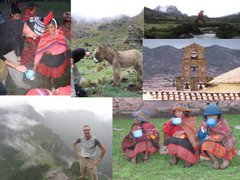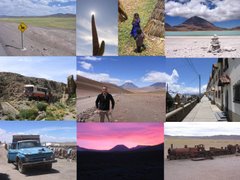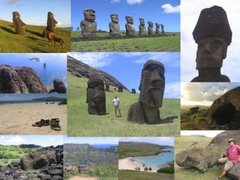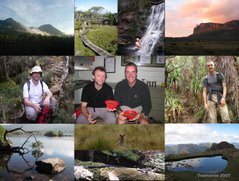 (Wallaby? ...mine's a Castlemaine XXXX)
(Wallaby? ...mine's a Castlemaine XXXX)Tasmania's Overland Track is one of the most feted wilderness walks in the world. The track stretches from north to south through the middle of the Cradle Mountain and Lake St Clair National Park, one of UNESCO's World Heritage List sites, alongside Machu Picchu, Easter Island and New Lanark (Scotland) amongst others.
But despite its well-organised nature and volume of walkers, we had been told that it was not a trek to be undertaken lightly. Popular theory suggests that the toughest day of the Overland Track is the first one. This is not due to the route itself, but rather the amount of gear (20kilos plus) you find yourself lugging around on your back. The Tasmanian Parks and
 Wildlife Overland Park booklet carries dire warnings about the consequences of not taking sufficient food and equipment - "you have to be ready for seven days in the wilderness". It wasn't exactly clear what the Australian definition of wilderness was but we assumed that the route wouldn't be characterised by an abundance of Starbucks and 7-11s.
Wildlife Overland Park booklet carries dire warnings about the consequences of not taking sufficient food and equipment - "you have to be ready for seven days in the wilderness". It wasn't exactly clear what the Australian definition of wilderness was but we assumed that the route wouldn't be characterised by an abundance of Starbucks and 7-11s.(Chris packs in preparation for the trip. Or gets ready for Mardi Gras, I'm not sure which...)
So we packed all the usual gear - tent, camping stove, sleeping bags, rain-macs, clothes, first-aid kit - plus a good weight of dried food. We budgeted for eight days worth of tucker, including no less than 21 cereal bars. This, of course, lasted six days.
As always when packing, i couldn't resist a few luxuries.
Chris had his pillow, his smoking jacket and p240-277 of the ladieswear section of the 1987 Kays Catalogue.
I packed a hard-back book.
But it was an essential one. Not the travel-friendly edition of Madonna's Erotica, but "Carniverous Nights:On The Trail of The Tasmanian Tiger", a book I can thoroughly recommend as an extremely apt and atmospheric companion to a trekking holiday in Tasmania. (Actually that may also apply to the Madonna book - if anyone can provide a first-hand opinion, please post a comment.) The book is a non-fictional account of a recent trip by two Americans across Tasmania and the creatures they encounter there.
They were actively seeking out the rare and the unusual. I would never have suspected we would find so many of these creatures ourselves.

It all started 30 minutes into day 1. As the park shuttle bus disappeared back towards civilisation and we lifted our rucksacks for the first time, we had to decide who would lead the expedition and thus be at greatest risk of standing on a snake. Chris pointed out that he had a distinct displeasure of snakes. And that he was concerned at his approaching responsibilities as a provider for a family of three. I thought it was very nice of him to include me in his financial planning as I had only been lodging with him for a few weeks, but on reflection he may have been referring to the fact that Caroline is six months pregnant.
So I took the lead - what could we possibly encounter on the first day? Quite a lot as it happened.
So there we were, less than a mile into the path, I having taken only about 100 photos and Chris having scratched his backside less than 20 times, when we rounded an overgrown corner on the track and - still within site of the car-park - a 6 foot-long Tiger Snake passed across the track, just 18 inches ahead of where I had just put my left foot.
I very nearly literally soiled myself. This rather lessened Chris' relief at having been directly behind me at that moment. The Tiger Snake is not only venomous but known to be deadly. It is timid and will avoid human contact, but will aggressively defened itself if attacked... or trodden on.
Fortunately, the snake shot into the scrub on the other side of the track and I was amazed at how quickly it disappeared. I could have been disappointed not to get a photo of it, but though I didn't know it, there would be plenty more opportunities...
 (Tiger snake! In defiance of his natural fear of anything long and slimey, Chris did spend a fair share of the time walking first and spotted this monster terrorising birds' nests on day 4. )
(Tiger snake! In defiance of his natural fear of anything long and slimey, Chris did spend a fair share of the time walking first and spotted this monster terrorising birds' nests on day 4. )Over the next 7 days Chris and I spotted 15 (yes, fifteen) snakes. Eight of these were Tiger Snakes, the other seven being copper-head snakes and white-chinned green snakes, all of which are poisonous.
After our first encounter, we spent much of the rest of that day tentatively creeping round corners and were more than relieved when we reached the camping ground that evening.
Our conversation round the camping stove was dominated with retelling the story of the snake, which i have to confess got several inches longer and several inches closer to my feet with each retelling.
Little did we know as we turned out the light (by which I mean head-torch) and put down our books (by which I mean Kays Catalogue pages) that our bestial encounters weren't over for the evening. Before you think Brokeback Mountain, I'm talking Tasmanian wildlife at it's wildest and cheekiest.
(Left - Oi!!!!! The Plundering Possum shows his posterior as he disappears into the eucalypts.)
(Right - Bennet's Wallaby is accustomed to trekkers - with a good zoom lens you can get some pretty good shots.)
We were woken at about 11pm by a possum unzipping (who needs opposable thumbs!?) my rucksack trying to get at my packets of tuna and jammy dodgers. I had my earplugs in and was only awoken by my rucksack being pushed into my legs at the bottom of the tent. On folding back the flap of the tent I found a possum the size of a small dog looking belligerent and somewhat short-sighted as it ripped a plastic bag out of my belongings.
Typically, he scarpered before i could get a good photo of him. But he wasn't the last nighttime raider. Chris was continually pestered by possums on the second night (he had most of the food on his side of the tent), who stubbornly returned at regular intervals, possibly because his deterent method (sitting up and saying "Oi!!!!" in a gerr-off-moi-land style voice every now and again) wasn't any deterent to a gang of hungry possums. When we woke up in the morning they had ripped our rubbish bag apart and strewn tuna packets across the clearing.
(Left - snake food. These skinks are the reason snakes are so common on the overland track.)
(Right - leech food. Chris' unfashionable legwear couldn't deter this gruesome hitcher.)
Our other scary encounter was about half-way through our trek. A particularly long day's walking finished in a hardy hike uphill through dense and marshy forest. At the end of this, during a much needed break, Chris found an unwanted 'hinger on' taking a drink from his shin. Luckily I was able to raid our condiment cupbard and got the beggar off with a good dose of salt (a well rounded tea-spoonful sprinkled liberally does the trick).

Our other wildlife encounters were more peaceful but no less interesting. Above is the fairly rare Echidna. According to the reknowned taxonomist George Gaylord Simpson, mammals can be subdivided into two groups - monotremes (the echidna and the duck-billed platypus) and therians (everything else, including you, me, whales, bats, you-name-it). So to see one of these beasts creeping around in the wild, sucking up ants was quite a privilige.
We also saw wombats, which i followed excitedly to their burrow, and pademelons - a rather sorrowful looking close-relative of the more staturesque wallaby.

(Left - wombats) (Right - pademelons)
Aside from making for some good photos and fireside yarns, there is a serious and fascinating message in all this. Tasmania's wildlife is beautiful, unique and perhaps surprisingly abundant, at least in remote places. But much of it almost certainly wouldn't exist at all if it weren't for the fact that the island is at least partially protected from man's influence by the Bass straight. This stretch of water cuts Tasmania off from the mainland, where Tasmanian Tigers and many species of Pademelons, Quolls and other marsupials have become extinct over the past thousand years.
Though none of the animals we saw are classified 'endangered', these species are nonetheless in a fragile state. In the last five years, fears have grown that the common red fox has reached Tasmania. If foxes became established on the island, all but the largest marsupials would be in dnager. As well as threatening the animals above, this could spell disaster for other endemic species that we didn't see - in particular, the Duck-billed platypus and the Tasmanian Devil.
I read my Carniverous Nights book from cover to cover over the course of the week. And I was particularly touched by the plight of the Tasmanian Tiger. The Australian government had once paid a bounty for the animals' skins, driving the species to the brink of oblivion. And though possible sightings have sprung up at regular intervals in the 70 years since the last animal died in a zoo in Hobart in 1936, the animal has now been classified extinct.
In 1936, two months after that last animal died (from exposure, incidentally, because the zoo staff didn't care sufficiently to let the animal into its hut one night) the Australian government conferred protected species status on the Tasmanian Tiger.
As with Easter Island, I'm moved by the lessons we can learn from the remotest and most unusual places.
 (Lastly, a picture of some nice swallows. Don't have nightmares.)
(Lastly, a picture of some nice swallows. Don't have nightmares.)












No comments:
Post a Comment